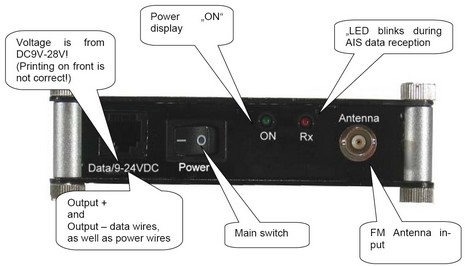AIS duplex vs multiplex, EasyAIS gets it right

I’m pleased to report—at least in part because of discussions here—that EasyAIS has rewritten its Web pages to clearly explain how its multiplexing receiver functions within the Class A and B System, particularly in relationship to more expensive full duplex receivers. In fact, they’ve put together the most thorough analysis I know of on the Web (go to home page, click on “AIS Capability). Besides laying out position reporting intervals in time and distance for various possible target vessels, they point up some other factors that suggest “additional uncertainty of class B reception, independent of the used receiver type.” EasyAIS concludes that both multiplex and duplex receivers “show satisfactory results for all class A scenarios,” but when “looking for fast class B targets, both concepts show weak points, as the information update rate is low.” One can argue that multiplexers are weaker in this regard, but the point is that users need to get educated about AIS target intervals as Class B becomes an actuality, and hats off to EasyAIS for now contributing to that education. (And Panbo rocks again!)













..except that I don’t think they really meant duplex (which means transmit and receive simultaneously in my world). Should it read something like:
“Differences between dual channel simplex Rx and dual channel multi-plex Rx”…????
I am still of the opinion that the “problems” with Class B have been blown out of proportion. Let’s face it, there aren’t many units out there yet, so asside from the trials by the UK Coastguard and the massive simulations conducted by the USCG, there is little or no firm data to base any conclusions on. Why don’t we just wait and see how it turns out in reality before condemming it.
Thanks, Del. I certainly hope I haven’t overstated my concerns about Class B. I’m very hopeful about its usefulness, just think there will be some growing pains. For instance, did you see the note that NASA receivers will need new eproms? Also, I think there’s a case for “duplex” as an effective term for a receiver (not transceiver) that uses two channels simultaneously. It’s similar to the more common use of duplex, only the simultaneous transmissions are both in the same direction.
I have to go with Ben here regarding the Class B problems and Del regarding the “duplex” issue…AIS is turning into a security issue as much as a navigational issue (at least here in the States). As the Security gurus are fond of saying, “we have to be right 100% of the time, they only have to be right once.” To be right 100% of the time means that EVERY vessel out there is gonna have to carry a Class B device. Imagine a busy harbor, New York for example, on a warm sunny summer day and then think of what an AIS display is gonna look like..
In RF communications, duplex is duplex, it’s an existing term describing a specific mode of operation, the ability to transmit AND receive. A receiver that has 2 channels is a “dual channel” receiver, and operates as a “simplex” device. A transponder (transmits and receives) that has 1 channel is a “single channel duplex” device…
But the problem is finding a good descriptive name for a single channel receiver that automatically switches channels (which are sometimes now being called dual channel). “One channel multiplexing simplex” is not going to work for many folks.
I’ve done some research into the notion that the U.S. government is going to mandate Class B AIS on every vessel, and think it’s pretty unlikely.
Agreed, that is the problem, but with all due respect, using an existing, well understood term erroneously isn’t the answer. In my other life, I am an audio engineer and as such use radio microphones. Our receivers are 2 channel to overcome the problems of multipath, etc. and are described as “diversity” type. Perhaps this an appropriate term for our use here?
I hope you are correct about Class B carriage requirements and with the recent changes in DC, perhaps the current focus on “security theater” will diminish. Just out of curiosity, what research has led you to conclude that it is unlikely?
Actually, according to Wikipedia
http://en.wikipedia.org/wiki/Diversity_scheme
diversity does do a good job of describing what we are talking about, and makes the problem with some AIS receivers very apparent. Namely, that 2 channel DIVERSITY receivers do not receive all AIS broadcasts. From a practical standpoint, since Class A systems can have 2 ships broadcasting at the same time (1 on channel A, 1 on Channel B), a 2 channel diversity RX will only be able to receive 1 of the broadcasts. A 2 channel NON DIVERSITY receiver will be able to receive both transmissions and thru multiplexing, be able to send both messages to the display device. Having used both types in the same geographic areas, I can say that 2 channel non diversity units do a much better job of plotting timely, position-accurate targets than diversity-based ones.
Well, I guess you’re right; I shouldn’t be fouling up a perfectly healthy tech word like duplex. But I think “diversity” has problems too; for instance it can be dual antennas working the same frequency. I hope someone will come up with an apt expression that sticks.
As to the AIS research, I’ll do an entry on it soon.
Well, yes, it can be a dual antenna system, among other things, but it is still a diversity system.
Interesting discussion. Have there ever been any estimates on how many vessels might equip with Class-B receivers? If there are too many, the current system might saturate, although the original STDMA concept included a feature to handle that locally.
I am tempted myself by the receivers, but I waited for the Class-B to appear. Now its a case of waiting for the price to fall. Snag is the best is the enemy of the good and IMO/IALA etc. are now looking at long-range AIS, receiving the ship’s VHF transmissions by satellites. The nice feature planned (by some)is to include a SMS capability.